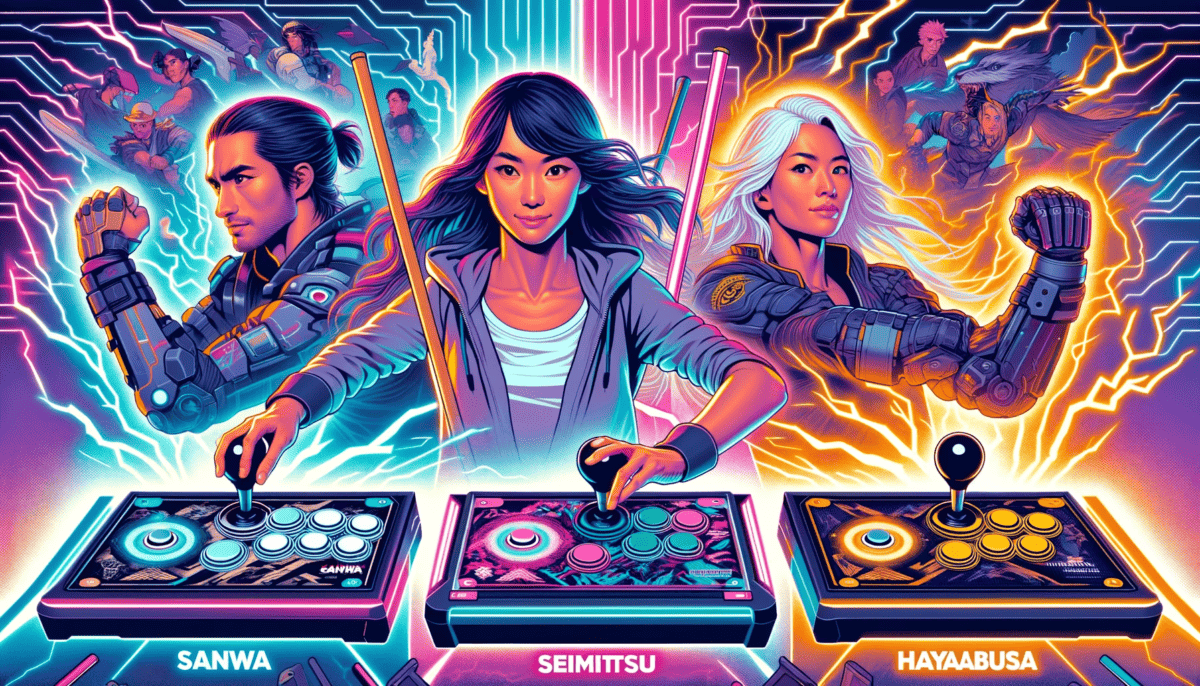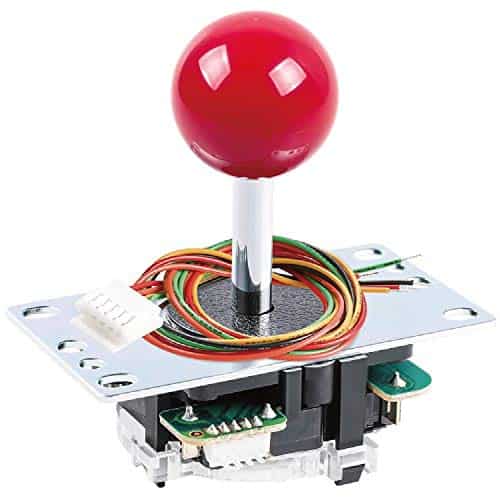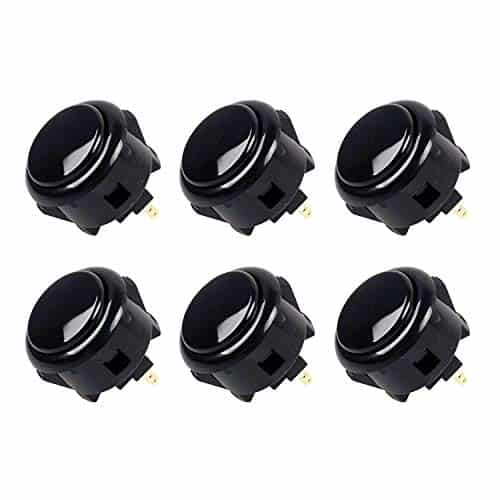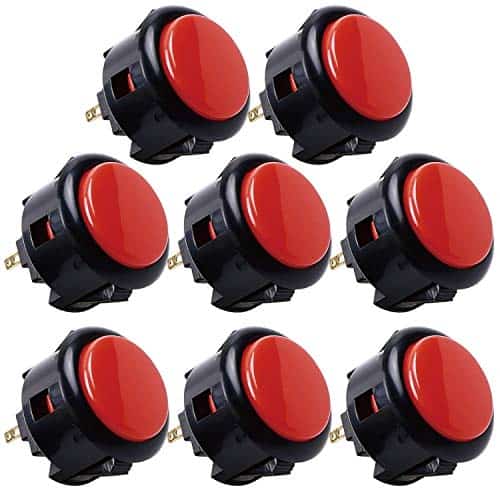Perhaps the best thing about fightsticks is the ability to customize them. Nearly everything in a fightstick can be replaced and swapped out. This includes the main functional parts, the buttons, and the joystick lever.
Not only does this improve durability, but you can also significantly improve the performance of a fightstick with the right parts. But that’s the question. So, what are the right parts?
It’s obvious from the title of this post what the right parts are. That is Sanwa, Seimitsu, and Hayabusa.
If you’re familiar with fightsticks or arcade sticks, you’ll know that having these famous brand parts means a high-quality stick.
This is because Sanwa, Seimitsu, and Hayabusa are highly quality.
Why do high-quality parts matter in a fightstick?
As mentioned, higher-quality parts significantly improve the performance of a fightstick. This mainly means better response times and enhanced durability of the stick. In addition, the ‘feel’ of the stick is a lot better.
This may not be easy to explain, but having a stick with Sanwa parts, for example, side by side with a stick with just stock parts, you’ll feel the difference in quality.
This ultimately means you can pull off moves more easily and improve your overall gameplay, which is the main objective of a fightstick.
This brings me to the final question. Which buttons or joystick lever should you get? Sanwa, Seimitsu, or Hayabusa? Well, worry not, my friend. In this post, I will compare the three brands and ultimately give my view on which is best.
Sanwa
Sanwa is synonymous with high quality, reliability, and excellent performance.
The brand is well-known worldwide and is made by the Japanese arcade parts manufacturer Sanwa-Denshi. Established in 1982, the company has made parts for Sega and Konami. In addition, most of the arcade cabinets in Japan contain Sanwa parts, so you know they’re good.
Sanwa Levers
- JLF-TP-8YT-SK (Link goes to Amazon)
- JLF-TPRG-8BYT-SK
- JLFD-TP-8YT
JLW-TM-8
Sanwa Buttons
- OBSF-30/24 (Link goes to Amazon)
- BSFE-30
- OBSFS-30
Examples of Sanwa Fightsticks
Here are some examples of Sanwa fightsticks. Click on the links to my read reviews of the stick.
Seimitsu
Although little is known about the company, Seimitsu produces high-quality parts for arcade sticks and cabinets.
They’re not as popular as Sanwa, but their joystick levers and buttons are known for having shorter throws and, as a result, being more responsive.
Seimitsu Levers
- LS-56/58
- LS-40
- LS-32
Seimitsu Buttons
- PS-14-KN
- PS-14-D
- PS-14-GN
- PS-15 30
Examples of Seimitsu Fightsticks
Unfortunately, there aren’t any fightsticks that come built-in with Seimitsu parts.
Hayabusa
Hori makes Hayabusa parts, well-established in the fightstick community and known for making quality parts and their famous RAP fightsticks.
Examples of Hayabusa Fightsticks
- HORI Real Arcade Pro 4 Kai
- HORI Real Arcade Pro V Switch
- HORI Real Arcade Pro N Hayabusa
- HORI Fighting Edge
Which parts are better?
To determine which parts are better, I will look at the feel and performance of each part for each brand: buttons and joystick lever. I will then declare a winner. Remember, this is based on my own opinion. You may disagree, and that’s fine.
Hopefully, the comparison below will allow you to make an informed decision as to which parts you prefer. Firstly, let’s look at the lever.
Levers comparison
A high-quality joystick lever will feel smooth and responsive. I prefer a square gate restrictor over an octagonal one, but that’s my preference.
| Brand | Features | Benefits | Advantages | Weaknesses |
|---|---|---|---|---|
| Sanwa | Compact, high-quality materials | Smooth, responsive, precise movement | Most popular, widely used in Japanese arcade cabinets | More expensive |
| Seimitsu | Shorter throw and engage distance | Faster movement, quick inputs | Good for certain games requiring less precision | Less suitable for motion-heavy games |
| Hayabusa | Made by Hori | Similar performance to Sanwa | Almost on par with Sanwa, close feel and performance | A slightly longer throw may feel a bit lose |
I will compare a Sanwa JLF-TP-8YT-SK(Standard Sanwa Lever), Seimitsu LS-40 (best for square gate), and the standard Hayabusa joystick lever.
1. Sanwa JLF (JLF-TP-8YT-SK)
The Sanwa JLF is probably the most popular joystick, and for a good reason: It’s very responsive. Moreover, because of how compact the JLF is and the use of high-quality materials, it can be very precise.
There aren’t any negatives, apart from being more expensive than rivals. But that makes sense, considering the high-quality materials used.
Testing the lever out, I got moves out on games like Street Fighter and Tekken pretty accurately with the minimum of dropped inputs and combos.
2. Seimitsu LS-40
Seimitsu LS-40 is cheaper than the Sanwa, meaning it’s slightly lower quality. However, the performance is still very good. The engage distance for the LS-40 is shorter than the Sanwa JLF. This means that it allows for quick movements to be registered on the stick.
However, a shorter throw and engage distance doesn’t necessarily mean more accuracy. The Seimitsu joysticks are great for certain games that may require less precision but faster movement, for instance.
However, it may not be suitable for games that are motion-heavy, e.g., street fighter.
I could tell this is the case after testing this on several fighting games, including Street Fighter. Although I’m getting moves out quicker, which is great, I don’t get it 100% of the time, meaning I do tend to drop crucial combos occasionally.
However, This can be rectified with practice and could mean that someone used to a Seimitsu lever could potentially have an advantage. That said, a Seimitsu lever is probably more suited to classic Shoot them-up-style arcade games than modern fighting games.
3. Standard Hayabusa Lever
The Hayabusa lever made my HORI very impressive. It’s pretty much similar to the Sanwa JLF in terms of performance and feel. This makes sense as the parts are quite similar.
Despite this, however, the Hayabusa lever slightly has a longer throw, which may sometimes feel a little loose.
Playing this lever with various fighting games, it performed well and, as mentioned, is almost on par with the Sanwa JLF. But something feels slightly off.
Don’t get me wrong; the motions are smooth, and, to the untrained eye, you may not even feel a difference between this and a Sanwa JLF. But for me, having played on several fighting sticks with Sanwa JLF, I could tell there was a difference.
However, it didn’t affect my gameplay, as I could still perform well and pull off moves and combos consistently.
Levers verdict
If this comparison were based on Shoot-them-ups, I would probably give this round to Seimitsu with the shorter engage and throw distance.
However, this post is all about testing on fighting games, so it’s probably no surprise that the best lever, in my opinion, is Sanwa JLF, with Hayabusa coming in second and Seimitsu last.
Winner: Sanwa JLF
Buttons comparison
What’s a fightstick without buttons? Nothing, that’s what. I will compare Sanwa OBSF, Seimitsu PS-14, and the standard Hayabusa buttons for this example. These are all 24mm, apart from the Hayabusa buttons, which are 30mm.
| Brand | Features | Benefits | Advantages | Weaknesses |
|---|---|---|---|---|
| Sanwa | Highly responsive, light to touch | Easy to pull off moves and combos | High-quality, durable, widely used | Overly responsive for some may cause accidental inputs |
| Seimitsu | Stiffer, shorter throw and engage | Less accidental inputs | Good for games requiring precise control of button presses | Less responsive than Sanwa buttons |
| Hayabusa | Made by Hori, matte finish | Similar responsiveness to Sanwa | Alternative to Sanwa, unique button finish | Slightly lower quality, noisier buttons |
1. Sanwa OBSF Buttons
Sanwa buttons are highly responsive and light to the touch. This is great because you can easily pull off moves and consistently execute combos.
Some people may argue that the buttons are perhaps too light. In other words, they are too responsive. Even the slightest touch could set them off, which has also been my experience. These people may prefer something more akin to Seimitsu buttons.
Despite this, Sanwa buttons are highly quality and likely to last a long time. Moreover, I can tell from personal experience that they can withstand much punishment.
2. Seimitsu PS-14 Buttons
Seimitsu buttons are known for being slightly less responsive and stiffer than Sanwa. This is by no means a bad thing, however.
Let me explain. I focus on movement in a game like Street Fighter while playing footsies. While I’m doing this, my fingers are resting on the buttons. With Sanwa buttons responsive to the touch, I will trigger unintended inputs that may ruin the match.
This has happened to me as well.
Seimitsu’s are still pretty responsive but not overly, meaning I wouldn’t have the same issue. In this case, the shorter throw and engage distance is handy and gives Seimitsu a unique advantage over Sanwa.
3. Standard Hayabusa buttons
Hayabusa buttons are a good alternative to Sanwa. They’re similar and very responsive, sometimes more so than Sanwa.
The quality, however, isn’t as good as Sanwa or even Seimitsu, for that matter. They’re noisy, for one thing. Sanwa buttons are noisy as well, but in a good way. They make an audible click sound, which I like. Hayabusa buttons don’t have the same sound and the lower quality shows.
Saying that, however, I like the matte finish on Hayabusa buttons, as opposed to the glossy ones you get on Sanwa and Seimitsu.
Buttons Verdict
There is no clear winner, to be honest. They all have positives and negatives. But If I had to pick a winner, I would say Seimitsu. This is surprising because I normally go for Sanwa buttons.
I like the shorter throw and engage distance, as It helps execute games like Street Fighter and Tekken.
Although I like Seimitsu the best, I must recommend Sanwa for the beginner. They’re more responsive and are likely to last longer while taking punishment.
Winner: Seimitsu
Conclusion
And there we have it. I hope this comparison has given you some insight into which parts to go for when building or modifying your fightstick.
Although this is based on my opinion, remember there is no right answer regarding high-quality parts. Remember to have fun tinkering with your fightstick and find what works for you. This may be through trial and error, but so be it.
After all, the ability to customize a fightstick is what I love about them.





